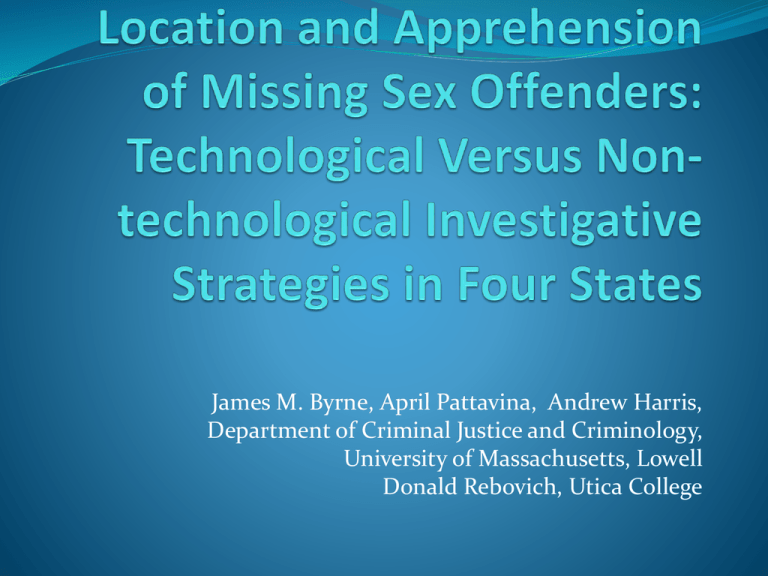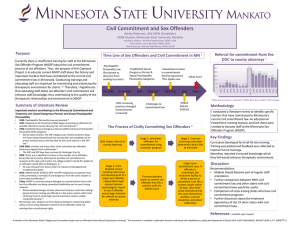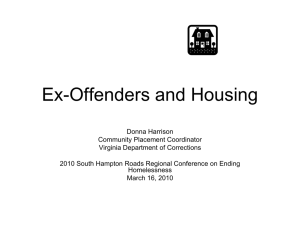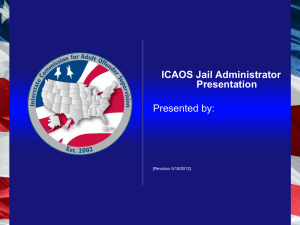
James M. Byrne, April Pattavina, Andrew Harris,
Department of Criminal Justice and Criminology,
University of Massachusetts, Lowell
Donald Rebovich, Utica College
Trends in Sex Offender Arrest,
Conviction, Sentencing, and
Control
Reported crime: Despite the media attention to sex abuse in the Catholic Church,
internet solicitation of minors on To Catch A Predator, and the recent stranger abduction
/assault cases involving Elizabeth Smart and Jaycee Lee Dugart, sex crime has been on
the decline over the past two decades, mirroring the overall decline in violence in this
country since the early 90’s.
Sex Crime Locations: About 40% of sexual assaults take place in the victim’s own home,
and 20% take place in the home of a friend, neighbor or relative (Bureau of Justice
Statistics, 1997).
Arrests and Prosecution: New categories of sex defendants are entering our federal and
state court systems, due to new laws , while new Federal, state, and local law enforcement
initiatives appear to have increased both sex crime reporting and clearance rates.
Sentencing: Compared to a decade ago, Sentences for convicted sex offenders are now
more likely to include incarceration, but the majority(60%) of all convicted sex offenders
are currently in the community corrections system.
Re-Offending: Sex Offenders are not a homogeneous group in terms of recidivism risk,
but overall, sex offenders pose the lowest risk of re-offending of all offender groups. The
U.S. Department of Justice found that over a three year period after being released from
prison, 5.3% of sex offenders were rearrested for a new sex crime (Bureau of Justice
Statistics, 2003).
The Community Control of Sex
Offenders: New Initiatives
Lifetime Supervision: Legislation has been passed allowing lifetime probation
or parole supervision for convicted sex offenders in twenty six states; in these
jurisdictions, GPS monitoring of offender location and movement is also the
norm.
New Classification and Reporting Procedures: Adam Walsh Act requirements –
if implemented fully—will increase the size of the registered sex offender
population, and mandate uniform offense-driven reporting requirements. To
date, only Ohio has substantially met these requirements.
Residency Restrictions: Many jurisdictions have passed legislation that restricts
registered sex offenders from living near schools, parks, libraries, bus stops,
and other places where children congregate.
Monitoring the Homeless Sex Offender Population: Due to residency
restrictions, a growing number of sex offenders are registering as homeless,
which requires new strategies for monitoring this subgroup of registered sex
offenders.
The Location of Registered Sex
offenders in The United States
Mapping Registered Sex Offender
Locations: An Ohio Illustration
Can Hot Spots Locations For
Registered Sex Offenders Be
identified?
In the Ohio illustration, it is apparent that registered
sex offenders are clustered in a small number of Ohio
Counties.
No research has been conducted to date on whether
sex offenders are locating in jurisdictions where
reporting requirements and/or monitoring strategies
are more lenient.
It is also possible that registered sex offenders are
locating/ clustering in those areas without residency
restrictions for sex offenders.
Estimates of the Size of the Missing
Sex Offender Problem
National Compliance Estimates by NCMEC: There are
approximately 100,000 sex offenders currently not in
compliance with sex offender registration/notification
requirements.
These estimates are based on telephone survey data,
which raises reliability concerns.
Compliance rates are likely to vary both within and
across states, due to a variety of factors, including
(1)resources,(2) qualifications of personnel ,(3)
monitoring frequency, and (4) access to technology.
An Overview of Our Case Study
Research Strategy:
Compliance: We need to understand how compliance with sex offender
registration requirements is monitored at the state and local level.
Non-compliance: We need to understand how investigators identify
sex offenders who are not in compliance.
Location: We need to understand the specific techniques,
technologies, and resources investigators use to locate missing sex
offenders.
Avoiding Detection: We need to understand why sex offenders
abscond, and how missing sex offenders avoid apprehension. We are
particularly interested in the use of ID Theft and/or ID manipulation.
Performance: We need to understand the key linkages that facilitate( or
impede) intra- and inter-state cooperation and coordination in the
location and apprehension of missing sex offenders.
Research Team for Case Studies
Our research team includes faculty from Utica College and
the University of Massachusetts, Lowell. Four State-Level
Case Studies have been completed to date:
Florida( Tallahassee and Orlando): Donald Rebovich and
James Byrne( June, July, 09)
Texas( Austin and San Antonio): Andrew Harris and James
Byrne( September, 09)
Connecticut: April Pattavina and Andrew Harris( June, 09)
California( Riverside): James Byrne( June, 09)
Additional Case Studies will be conducted over the next
two months in Ohio, Oklahoma, California( San Diego)and
Hawaii.
Case Study Site Selection Strategy
Three initial criteria: size, location, and innovation
Our First Site Selection Criterion: Size
We have conducted site visits of the three State systems
with the largest number of Registered Sex Offenders:
California, Texas, and Florida; approximately 33% of all
registered sex offenders in the United States reside in these
three states.
We have also identified three states—Connecticut,
Oklahoma, and Hawaii– with much smaller number of
registered sex offenders to determine whether “size
matters” in terms of how sex offenders are monitored, and
the techniques used to locate missing sex offenders.
Case Study Site Selection
Our second criterion was location: we wanted to
conduct site visits in each region of the country:
Northeast( Connecticut),
Midwest ( Ohio, Oklahoma),
South ( Florida, Texas),
West ( California), and
Islands/territories( Hawaii)
Case Study Site Selection
Our third criterion was evidence of innovation and
effectiveness.
To identify high functioning state systems, we
reviewed available data on state-level compliance
rates, while also interviewing Sex Offender Sentencing
Monitoring Apprehending Registering and Tracking
(SMART ) Policy Advisor, Lori McPherson.
Several state systems were identified as potential sites,
including Ohio, California, Florida, Texas, and Hawaii.
Connecticut and California
Case Studies
Connecticut: Interviews conducted with key members of
the Sex Offender Registry Unit( SORU), a division of the
Connecticut State Police, including:
State Police Lieutenant Sam Izzarelli, the unit director, and
Sergeant Joseph Biela, the unit’s operations manager.
California: In Riverside County, interviews were conducted
with key members of the Sexual Assault Felony
Enforcement(SAFE) Task Force, including
Task Force Director, Supervising Investigator Ron Garcia
from the Riverside County District attorney’s Office; and
Sergeant Lori Marquette, Task Force Assistant Director
from the Riverside County Sheriff’s Department.
Florida Case Study: Tallahassee
In Tallahassee, Florida we interviewed the following
individuals:
Mary Coffee, Planning and Policy Administrator, Florida
Offender Registration and Tracking Services(FORTS)
Members of the absconder team, Registrant Tracking and
Systems Development Unit, FORTS; including Jon Roddenberry,
Robin Stevens, and Stephanie Hires.
Florida Computer Crime Center, Florida Department of Law
Enforcement, Special Agent Supervisor Mike Phillips.
District Court Probation, Ronnie Whitmire.
Department of Corrections Absconder Unit Director Vernon
Barber.
Tallahassee Police Department, Officer David Northway
Florida Case Study: Osceola County
In Central Florida’s Osceola County, interviews were
conducted with the following individuals:
Detective Robert Tyrell, Director, Central Florida Task
force
Special Agent Yesenia Leon-Baron, Florida
Department of Law Enforcement
Texas Case Study
In Austin Texas, we interviewed the following
individuals:
Sergeant Greg Moss, Director, Sex Offender Unit,
Austin Police Department
Scott Merchant and Vincent Castilleja, Texas
Department of Public Safety
In Dallas Texas, an interview was conducted with
Agent Andre O’Bryan, a member of the Dallas-fort
Worth High Risk sex offender Task force
Key Findings from Initial Site Visits
Finding 1: The responsibility for monitoring compliance
with sex offender registration and for locating absconders
varies from state to state. There are three distinct models:
Centralized, decentralized, and Hybrid.
Centralized systems typically established a statewide sex
offender unit to manage compliance/ non-compliance.
Decentralized systems view compliance/non-compliance as
either a local , county, or regional responsibility of law
enforcement.
Hybrid Systems combine features of centralization( the
registry data base and/or initial registration) and
compliance monitoring ( by local police or Task Forces)
De-centralized Sex Offender
Registration, Monitoring, and
Location
Texas: In Texas, the initial registration, monitoring
compliance, and absconder location/apprehension is a
decentralized function; in some parts of the state( e.g.
Dallas) Multi-Agency Task Forces have been established,
but in many areas the responsibility falls on local police
departments. The statewide sex offender registry data base
is maintained by the State Office of Public Safety.
California: In California, monitoring compliance and
absconder location/apprehension is decentralized , and
county task forces have been established and maintained
utilizing Federal grants to support the program, including
overtime for project personnel and access to technology
designed to locate missing sex offenders.
Hybrid Model
Connecticut: In Connecticut, a hybrid model is used.
There is a centralized registration process managed by
the State Police’s Sex Offender Registry Unit.
Responsibility for locating and apprehending
missing/non-compliant sex offenders is generally
decentralized and left to local police agencies
throughout the state.
However, the State Police in Connecticut are involved
in location and apprehension if the sex offender’s last
known residence is in one of the towns covered by the
state police.
Finding 2:Reporting Requirements
For Registered Sex Offenders Vary
Florida: The current requirement is one in-person address verification—by the
absconder unit-- per year for all registered sex offenders. For those individuals
classified as sexual predators, four verifications per year are required.
Texas: The current requirement is one address verification per year. Sex
offenders who have been civilly committed( n=1200), or transients( 1500
statewide) are required to verify address every thirty days. Sex offenders with 2
or more priors must appear every 90 days at a local police department.
Connecticut: All registered sex offenders must verify their residence every 90
days, via a mail-based address verification system. In addition, they must
inform the Registry within 5 days of any changes in name, place of
employment, school, and internet identifiers.
California: In Riverside County, SAFE team members conduct at least one
address verification per year, but due to contacts/verication by probation,local
law enforcement, and/or the Sheriff’s office, it is estimated that each registered
sex offender is “seen” 2-3 times per year.
Finding 3:Intra-and Inter-Statelevel Variation in Compliance Rates
Florida: Variation in compliance rates identified by county( and within
county, by circuit), but overall non-compliance estimated at 5%( with
50,000 registrants).
Texas: According to the Director of the Sex Offender Registration
system, about 12% of the 57,000 active cases on the system are in noncompliance; in a significant number of these non-compliance case,
system errors—not offender non-compliance—are the problem.
However, no jurisdiction –specific compliance rates have been
calculated to date.
Connecticut: About 8%(400) of the 5000 registered sex offenders in
Connecticut are currently listed as non-compliant; the majority of
these have failed to mail in an address verification.
California: Significant intra-state variation in non-compliance rates has
been identified, with a low of 4.9% in San Diego ( with 4000
registers)to a high of 25% non-compliance in Los Angeles( with over
15,000 registers).
Finding 4:We did not find a Link
Between Missing Sex Offenders and
Identity Theft/Manipulation
Florida: Offenders certainly use aliases, but ID Theft is
rare.
Texas: No evidence of ID Theft, but aliases are always
used to avoid detection during police stops.
Connecticut: Offenders attempt to change appearance,
and use aliases; no cases of stolen identities.
California: In a few cases, offenders left the country
and returned illegally using a “fake” identity.
Finding 5:The Technology Available
to Locate Missing Sex Offenders
varies both within and across states
Florida: Investigators have access to a broad range of
local, state, and national data bases, including both
commercial and public agency data bases.
Texas: recent cuts in Federal grants have resulted in
fewer personnel, which translates to limitations in the
types of searches completed on available data bases.
Connecticut: Investigators rely on U.S. Marshal’s
Service to locate “hard to find” missing sex offenders.
California: Jurisdictions with active Task Forces appear
to have greater access to technology.
An Overview of Investigative
Techniques Used to Locate Missing
Sex Offenders
Technological Techniques:
Registry of motor vehicle address
checks
Check out-of-state drivers license
information
Social Security Administration
address checks
Searches using commercial data
bases, including Lexis/Nexus and
Accurint
Check death index, vital statistics
Check immigration and customs
Biometrics/ facial recognition scans
of drivers license data base
Check all available in-state law
enforcement and corrections data
bases
Non-technological Techniques:
Check last known address
Routine follow-up interviews with
family, friends, neighbors, and
employers
Arrest warrant issued
Non-compliance sweeps
Follow-up interviews with
probation, parole
Check with prison/jail intake to see
whether the offender was
incarcerated
Review criminal history for aliases
Finding 6:Non-technological “Old School”
Investigative Strategies appear to be
consistently used across jurisdictions to
Locate Missing Sex offenders
Florida: Investigators find that even when missing sex offenders move
away to avoid detection, they move to areas where they have family ties.
In these cases, the key is knowing where relatives reside.
Texas: Investigators indicated that they “worked” these cases as fugitive
apprehension cases, beginning with interviews of family, friends,
relatives, and coordinating intelligence with the statewide fugitive
apprehension unit and, where applicable, the U.S. Marshal’s Service.
Connecticut: Over half of all missing sex offenders were located last
year during grant-supported sweeps of areas where these offenders
were thought to reside.
California: While new data systems are often a timesaver, it is the “old
school” techniques that result in the location of the majority of sex
offenders; most are located within three months of being officially
listed as “missing”.
Finding 7:The Role Of The U.S. Marshal
Service varied in the Four States
Florida: active role, including Task Force participation.
Texas: to date, only a limited role, but due to resource
constraints, it is anticipated that the U.S. Marshal’s
service will be more active in the future for cases
involving out of state location and apprehension.
Connecticut: moderate role, linked to hard to find
missing sex offenders; every few months, a list of active
warrants for missing sex offenders is forwarded to
NCMEC.
California: limited role in Riverside County, but more
active in other parts of the state.
Issues To Consider: Final Thoughts
Centralized vs. Decentralized Sex Offender Registration,
Monitoring, Location, and Apprehension Practices
Interstate Transfer of Sex Offenders
Interstate Cooperation in the Location and Apprehension
of Missing Sex Offenders
Identity Theft and Identity Manipulation among Missing
Sex Offenders
Technological vs. Non-technological Location Strategies
Are Missing Sex Offenders Really
Missing?
Florida: Verification of residence becomes more
difficult when the offender is homeless.
Texas: Non-compliance may be a function of clerical
errors at the local level in this decentralized system.
Connecticut: Non-compliance has been linked to
mail-in verification system gliches.
California: In some parts of California, a sex offender
can move without notification and not be considered
in violation if he subsequently—upon detection—
agrees to re-register.
The Absconders: Where Are They?
How do they avoid detection?
Florida: Investigators believe most absconders remain in the state, but
move to large cities, work as day laborers, do not obtain credit cards in
their name, and use multiple names during police contacts( in
particular Hispanic sex offenders).
Texas: The vast majority of missing sex offenders are located within the
state, using “old fashioned” non-technological police work( starting
with a visit to the last known address)
Connecticut: Investigators here believe absconders attempt to use a
variety of addresses to avoid initial detection; some will change their
physical appearance to avoid detection; others become homeless,
making them difficult to track.
California: The majority of absconders in Riverside County moved
without notification to another part of the state; a small number leave
the state and a handful have left the country. In only two cases did the
offender employ identity theft to avoid detection.
Next Steps in the Research Process
U.S. Marshal Service Interviews
Florida follow-up
Texas follow-up
Connecticut follow-up
California follow-up
Ohio
Oklahoma
Hawaii
Examination and Analysis of StateLevel Sex Offender Registry Data
Sets
Offender Profiles
Offense Profiles
Mapping Registered Sex Offender Locations
Mapping Missing Sex Offender Locations
Identity Manipulation by Registered and Missing Sex
Offenders
OVERVIEW OF TEXAS SEX OFFENDER REGISTRATION PROCESS
1. Registration Initiated
Prison/jail releases (TDCJS/Local jails)
New convictions w/ community sentences (Courts)
CR-35 Registration Form
Record
created
Central Registry
managed through
Texas DPS
3. Registrant
appears to verify
initial registration?
Copy
POLICE
UPDATE SOR
RECORDS
2. Local police in
registrant
jurisdiction
notified
Record
created
Local police
tracking system
Yes
No
4. Registrant
appears for
periodic
verifications?
(Monthly,
quarterly, annually)
Local Investigation
Local
identification
and
apprehension?
YES
1a. Notification
of registrant
relocation to
jurisdiction (from
initiating
jurisdiction)
4a. Mandatory registrant
reporting of changes to
address, employment,
internet identifiers
Local compliance
checks to verify
information
Failure to update information
FTR Arrest
NO
Fugitive absconders
referred to Attorney
General Fugitive
Apprehension Unit
and/or USMS
OVERVIEW OF CONNECTICUT SEX OFFENDER REGISTRATION SYSTEM
Prison/jail releases
Registration initiated by
Connecticut DOC
Qualifying convictions
released to community
(probation, community
sanctions) Registration
initiated by offender
SORU
INITIATES SOR
RECORD
CONNECTICUT
SEX OFFENDER
REGISTRY
Address verification
letters sent to all
registrants every 90 days
SORU Verification
no
SORU DAILY COURT
REPORTS
SORU Verification
Other court-ordered
registrations (judicial
discretion) Registration
initiated by offender
Relocation of individual to
Connecticut for work,
school, or residence
(permanent or temporary)
Registration initiated by
offender
SORU
UPDATES SOR
RECORD
Investigative Report sent
to local jurisdiction
Signed letter
returned in 10 days?
yes
Arrest warrant prepared
Warrant Granted?
Documentation
submitted via local
law enforcement or
directly to SOR
Mandatory registrant
reporting of changes to
address, employment,
internet identifiers
Photo Updates
every 5 years or
per SOR request
yes
no
Efforts to re-establish
compliance
Location,
apprehension,
and arrest by
local police
Fugitive absconders
referred to
NCMEC/USMS
Overview of Florida Sex Offender Registration,
Monitoring and Location Process
Overview of California Sex Offender Registration,
Monitoring, and Location Process









